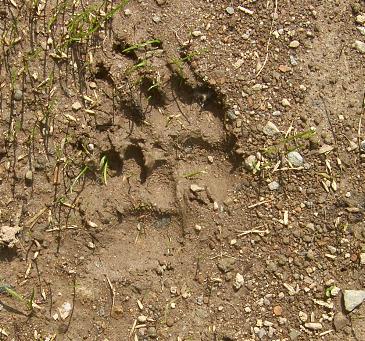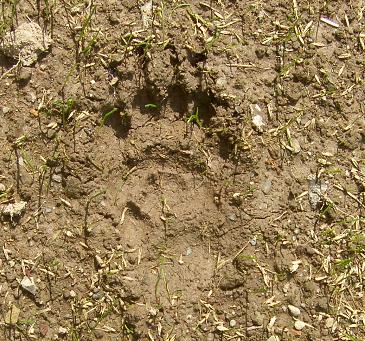
Holes made by badgers as they dug for insect larvae, Starlings and Rooks can pull up moss and thatch, but do not dig holes.
Sometimes more affectionately known as Brock or Broc which is of Celtic origin, Badgers are members of the weasel family and are social, mainly nocturnal animals. Unfortunately the most frequent sighting of one is as a corpse on the side of the road and this accounts for about fifty thousand per year. In the garden it is the damage that they cause while foraging for larvae which is the first sign that they are present. The damage seen in the picture above can also be caused by foxes and sometimes by squirrels, but badger damage is usually more severe. They will also dig up and eat some of the bulbs such as tulips and crocuses.
Although they are timid creatures, if cornered they can be ferocious. As children growing up in the countryside we were warned never to confront them as they would bite until they could hear the bones crunching, and for this reason at a time when they were hunted, the hunters would pack cinders around their ankles to mimic the sound.

Captured on a trail camera at night.
As social animals they live in groups of up to 14 in underground, labyrinthine tunnels called a sett which can be up to a century old. This is usually in sloping ground where the soil is well drained, among trees and shrubs. They do not like disturbance so do not tend to settle close to human habitations, but the expansion of urban areas frequently brings them into contact and some agricultural activity or other developments can force them to move to a new site. They can sometimes be seen in the garden in the early evening as they go out on their search for food, if their sett is close by. The route they take tends to follow a regular pattern.
 |
 |
the claws show well in the soft soil of this freshly sown patch of grass.
Badgers are omnivorous so as well as worms and larvae, they will eat flower bulbs, fruits and vegetables. They tend to suck worms from the surface, but the small pits excavated in the search for the larvae of cockchafers, leatherjackets and other cutworms, can be up to 15cm deep and leave the lawn looking a mess. They will take small mammals such as rabbits, rats, mice and hedgehogs so smaller pets may be at risk if not secured at night. The decline in hedgehog numbers, down by a third in 10 years, has been partially blamed on the recent increase in badgers which are their main predators. In areas where the trial culling of badgers has been carried out, hedgehog numbers have more than doubled. Also in urban areas where badgers are absent hedgehogs are more numerous than rural locations.
When the ground is frosted they may raid dustbins for an easier meal.
They dig a hole to use as a latrine. It is usually about 15cm deep and the same wide, and used by more than one member of a group. The faeces is deposited in the hole and not covered. The same hole is used again until full as seen in the picture below with older deposits slightly washed down by rain. These can be used to mark territory as the faeces has scent from an anal gland to warn off members of rival groups.

Badgers can contract bovine tuberculosis and this has made them the focus of attention of livestock owners as they too can suffer from this disease which debilitates them and it can be transferred to humans. This costs the agriculture industry and the government millions every year as any stock that shows signs of the disease have to be destroyed. Also the movement of farm animals is restricted so this places a further burden on the industry. There is much controversy over the issue with some people calling for a cull of badgers to stop the spread of the disease and others who say that they are not to blame.
The Protection of Badgers Act (1992) makes it an offence to kill, injure or capture a badger as is interfering with a sett. However there still exists the illicit practice of badger baiting where a captured animal is pitted against a dog in a fight.
If they are causing damage to the garden there is little that can be done apart from installing fencing to block their entry.
Preventive measures include:
Back to GARDEN CREATURES top /\